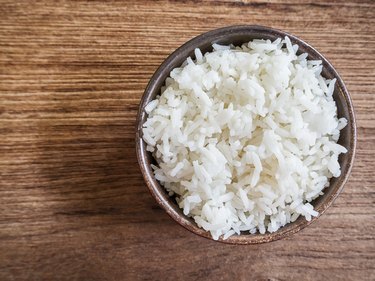
Also known as Thai fragrant rice or Thai Hom Mali rice, long-grained jasmine rice doubles the pleasure of eating a steaming bowl of fluffy rice because of its delicious, nutty taste and characteristic flowery aroma. Jasmine rice is a simple carbohydrate.
White jasmine rice is simplistic in its nutritional benefits. Jasmine rice can complement an already healthy diet high in vegetables, fruit, and lean protein. Brown jasmine rice offers the additional benefit of fiber, which is important for every diet. Rice is a foundation food for over half of the population of the world. It provides an inexpensive, often easily accessible source of nutrition in areas where other food may be in short supply.
Video of the Day
Video of the Day
Tip
While jasmine rice is a good source of carbohydrates, it is lacking in other important nutrients such as protein.
Jasmine Rice Nutrition
According to the USDA , 3/4 cup of cooked white jasmine rice contains:
- 160 calories
- 3 grams of protein
- 36 grams of carbohydrate
- 0 grams of fiber, fat, iron, cholesterol
When brown rice is processed into white rice, most of the vitamins and minerals are stripped. Most jasmine rice is not enriched. Enriching a food allows the manufacturer to add vitamins and minerals to a food that may have been lost during processing. Some rice is enriched with B vitamins and iron, so reading labels is essential if you are looking for those nutrients.
Read more: How Is White Rice Healthy for Our Body?
Is Jasmine Rice Healthy?
When combined with drinking plenty of water, eating jasmine or any other types of rice — especially whole grain, or brown, jasmine rice — may help prevent constipation. Because brown jasmine rice contains a fair amount of insoluble fiber, it can benefit digestion by helping flush food quickly through the gastrointestinal tract and softening stools.
Jasmine rice is often eaten alongside other healthy foods. When used as a complement to a diet high in vegetables, legumes, beans, fruits, and lean meats, it provides a healthy source of carbohydrate.
For athletes engaging in high intensity or endurance exercise, it can be a challenge to meet daily carbohydrate requirements to maintain glycogen levels, the storage form of carbohydrate in your muscles. White or brown jasmine rice is a good refueling food to pump glycogen back into the muscles and be ready for the next workout.
Rice is not a high quality — or complete — protein, which means it does not contain all essential amino acids. Eating foods that contain essential amino acids not produced in the human body is crucial for maintaining healthy, functioning muscles, and metabolism.
Consider Fiber and Blood Sugar
The jasmine rice perhaps most familiar to the Western palate is long-grained, smooth-textured and pearly white. Whole grain, or brown, jasmine rice retains the bran, or outer husk. Brown jasmine rice is more nutritious and higher in fiber than the white, water-milled version.
Research has found that those who have more fiber in their diets are at a reduced risk for heart disease, obesity, and Type 2 diabetes, according to the Harvard T.H. Chan School of Public Health.
Jasmine rice is regarded as a high glycemic index, or GI, food, according to a November 2013 study published in International Journal of Food Sciences and Nutrition. A GI score indicates how quickly a food will raise your blood sugar. A high GI food has a score of 70 or above and researchers found jasmine rice to be anywhere from 96-116 on the GI scale.
White jasmine rice is a starchy, refined food and, as such, temporarily raises blood sugar levels. Those with diabetes should choose brown jasmine rice over white jasmine rice.
Was this article helpful?
150 Characters Max
0/150
Thank you for sharing!
Thank you for your feedback!